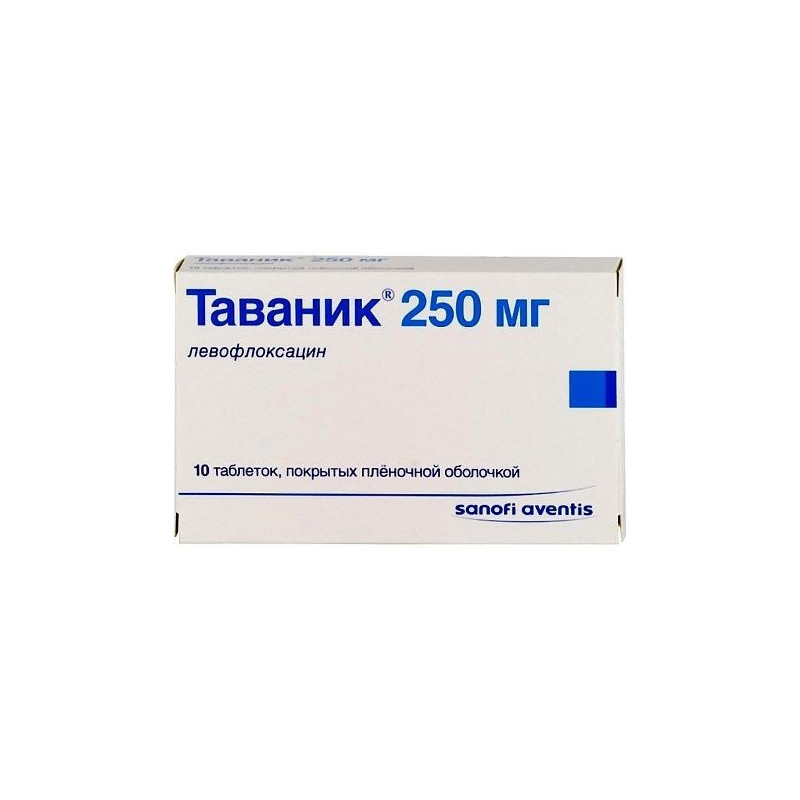



 All payments are encrypted via SSL
All payments are encrypted via SSL
 Full Refund if you haven't received your order
Full Refund if you haven't received your order
Coated Tablets
1 pill contains Levofloxacin 250 mg;
Excipients: crospovidone; methyl hydroxypropyl cellulose; MCC; sodium fumarate; macrogol 8000; talc; titanium dioxide (E171); iron oxide red (E172); iron oxide yellow (E172)
10 pieces.
Tavanic is an antibacterial drug of the fluoroquinolone group. It has a wide spectrum of antimicrobial action.
Acute sinusitis; exacerbation of chronic bronchitis; community-acquired pneumonia; complicated urinary tract infections (including pyelonephritis); uncomplicated urinary tract infections; prostatitis; infections of the skin and soft tissues; septicemia / bacteremia associated with the above indications; intra-abdominal infection; for the complex treatment of drug-resistant forms of tuberculosis.
Hypersensitivity to levofloxacin or other quinolones; epilepsy; tendon lesions in previously treated quinolones; childhood and adolescence (growth period) up to 18 years; pregnancy; lactation period.
Carefully: in the elderly due to the high probability of a concomitant reduction in renal function. Glucose-6-phosphate dehydrogenase deficiency due to the risk of hemolysis.
The drug is taken orally 250-500 mg 1-2 times a day. Doses are determined by the nature and severity of the infection, as well as the sensitivity of the suspected pathogen. To take pills inside, without chewing and washing down with enough liquid (from 0,5 to 1 glass), before food or at any time between meals. It should strictly adhere to the instructions for use, because otherwise Tavanic may cause inadequate effect.
Allergic reactions: sometimes itching and redness of the skin; rarely, anaphylactic and anaphylactoid reactions (manifested by symptoms such as urticaria, bronchospasm, and possible severe suffocation); very rarely - swelling of the skin and mucous membranes (for example, in the face, larynx), a sudden drop in blood pressure, shock, allergic pneumonitis,vasculitis; in some cases, Stevens-Johnson syndrome, toxic epidermal necrolysis (Lyell's syndrome) and exudative erythema multiforme.
Dermatologic: very rarely - photosensitivity.
Gastrointestinal: often - nausea, diarrhea, increased activity of ALT, AST; sometimes - loss of appetite, vomiting, abdominal pain, digestive disorders; rarely, an increase in serum bilirubin, diarrhea with blood (in very rare cases, this may be a sign of intestinal inflammation or pseudomembranous colitis); very rarely - hepatitis.
Metabolism: very rarely - hypoglycemia (manifested by a sharp increase in appetite, nervousness, sweat, tremors). Experience with other quinolones suggests that they can cause exacerbation of existing porphyria, in some cases, this effect is not excluded when using the drugTavanic.
Nervous system: sometimes - headache, dizziness and / or stiffness, drowsiness, sleep disturbances; rarely, depression, anxiety, psychotic reactions such as hallucinations, paresthesias in the hands, tremors, agitation, convulsions, and confusion; very rarely - impaired vision and hearing, impaired taste and smell, a decrease in tactile sensitivity.
Cardiovascular: rarely - tachycardia, a fall in blood pressure; very rarely - vascular collapse; in some cases - prolongation of the QT interval.
Musculoskeletal system: rarely, tendon lesions (including tendonitis), joint and muscle pain; very rarely - tendon rupture, for example, Achilles tendon (can be bilateral and manifest within 48 hours after the start of treatment), muscle weakness (is of particular importance for patients suffering from asthenic bulbar paralysis); in some cases - rhabdomyolysis.
Urogenital: rarely, an increase in serum creatinine level; very rarely - deterioration of renal function up to acute renal failure (for example, due to allergic reactions - interstitial nephritis).
Hemic and lymphatic: sometimes - eosinophilia, leukopenia; rarely neutropeniathrombocytopenia (increased tendency to hemorrhage or bleeding); very rarely - agranulocytosis and the development of severe infections (accompanied by persistent or recurrent fever, inflammation of the tonsils and persistent deterioration of health; in some cases - hemolytic anemia, pancytopenia.
Other: sometimes asthenia; very rarely - fever, allergic pneumonitis. Any antibiotic therapy can cause changes in the microflora (bacteria and fungi) that are normally present in humans.
Local reactions: often - pain at the injection site, redness, phlebitis.
It is recommended to continue taking the drug Tavanic for at least 48–78 hours after normalization of body temperature or after reliable destruction of the pathogen.
In order to avoid photosensitivity, patients should not be exposed to strong solar or artificial ultraviolet radiation.
Careful monitoring of blood glucose levels in diabetic patients receiving oral hypoglycemic agents or insulin is recommended.
If pseudomembranous colitis is suspected, the drug should be immediately discontinued and appropriate treatment should be initiated without using drugs that suppress intestinal motility.
If you suspect tendonitis, you should immediately cancel the drug Tavanic and begin appropriate treatment.
During the period of treatment, it is necessary to refrain from driving vehicles and practicing potentially hazardous activities that require increased concentration and psychomotor speed.
Weaken the effect by reducing the absorption from the gastrointestinal tract and systemic concentration: sucralfate, Magnesium and aluminum-containing anti-acid agents, iron salts, zinc-containing multivitamins, didanosine, therefore, it is necessary to observe at least 2 hours between taking these funds and levofloxacin.
With the simultaneous use of the drug Tavanic and theophylline, it is necessary to conduct a thorough monitoring of the level of theophylline and the corresponding dose adjustment.
Careful monitoring of MHO, prothrombin time and other indicators of coagulation, monitoring of possible signs of bleeding with simultaneous use of the drug Tavanic and Warfarin are necessary.
NSAIDs may increase the risk of CNS stimulation and seizures.
Store in a dry place at a temperature not higher than 25 ° C.
